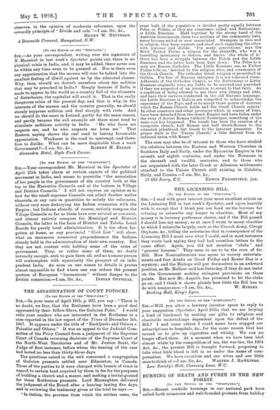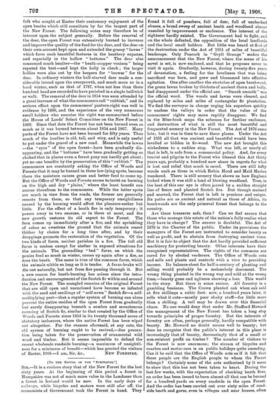BURNING OF HEATH AND FURZE IN THE NEW FOREST.
['to THE EDITOR or THE SP scrAToR.-.1 • SIR,—Recent roadside burnings in our national park have called forth numerous and well-founded protests from holiday
folk who sought at Easter their customary enjoyment of the open heaths which still constitute by far the largest part of the New Forest. The following notes may therefore be of interest upon the subject generally. Before the removal of the deer, the open Forest was extensively burned to increase and improve the quality of the feed for the deer, and the deer on their own account kept open and extended the grassy "lawns " which form such beautiful features in the heathery expanse, and especially in tbe hollow "bottoms." The deer also consumed much heather—the 'heath-cropper venison" being • reputed the best—and kept the holly in check ; the larger . hollies were also cut by the keepers for "browse" for the • deer. In ordinary winters the half-starved deer made a con- siderable inroad upon the overgrowth, and much more so in a , bard winter, such as that of 1787, when not less than three hundred head are recorded to have perished in a single bailiwick or walk. The removal of the deer in 1854 was soon attended by a great increase of what the commoners call "rubbish," and its serious effect upon the commoners' pasture-right was well in evidence by 1$66, and the experience of the very numerous small holders who exercise the right was summarised before the souse of Lords' Select Committee on the New Forest in 1868. Since that date the Forest has not been burned even as much as it was burned between about 1854 and 1867. Many parts of the Forest have not been burned for fifty years. Thus much of the heather is old, tall, and wiry, and is only useful to put under the gravel of a new road. Meanwhile the lawns —the " eyes " of the open forest—have been gradually dis- appearing, and the " bottoms " have been gradually getting so • choked that in places even a forest pony can hardly get about; yet no one benefits by the preservation of this "rubbish." The commoners are constantly asking the Office of Woods and Forests that it may be burned in these low-lying spots, because there the moisture causes grass and better feed to come up. But the Office of Woods and Forests seems to insist on burning on the high and dry "plains," where the least benefit can accrue therefrom to the commoners. While the latter spots are much in view from the roads, the former are generally • remote from them, so that any temporary unsightliness caused by the burning would affect the pleasure-seeker but • little. For the effect of a heath fire is only temporary ; it passes away in two seasons, or in three at most, and the new growth restores its old aspect to the Forest. The fern comes up immediately after a fire, and the sprinkling of ashes so sweetens the ground that the animals resort thither by choice for a long time after, and by their droppings promote the restoration of the vegetation. Of the - two kinds of furze, neither perishes in a fire. The tall old furze is useless except for shelter in exposed situations for • the animals. The groundling " bed " furze, on which . the - ponies feed so muoh in winter, comes up again after a fire, as does the heath. The same is true of the common furze, which the animals nibble so long as it is tender. A furze-brake will die out naturally, but not from fire passing through it. But a new reason for heath-burning has arisen since the intro- duction and encouragement of the Scotch fir within and around the New Forest. The mangled remains of the original Forest that are still open and unenclosed have become so infested with the seed and seedlings of "self-sown" Scotch fir—a self- multiplying pest—that a regular system of burning can alone prevent the entire residue of the open Forest from gradually • but surely disappearing beneath a sombre and monotonous covering of Scotch fir, similar to that created by the Office of Woods and Forests since 1854 in its twenty thousand acres of statutory inclosnres, where the native Forest has been wiped out altogether. For the reasons aforesaid, at any rate, the old system of burning ought to be revived,—due precau- tion being taken for the preservation of ornamental wild wood and timber. But it seems impossible to defend the recent wholesale roadside burning—a maximum of unsightli- ness for a minimum of benefit—which has greeted the visitors
of Easter, 1908.-1 am, Sir, &c., NEW FORESTER.









































 Previous page
Previous page